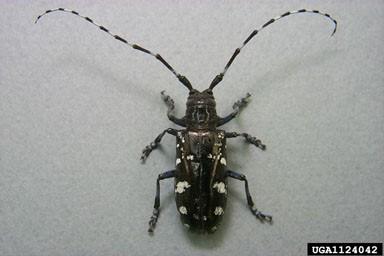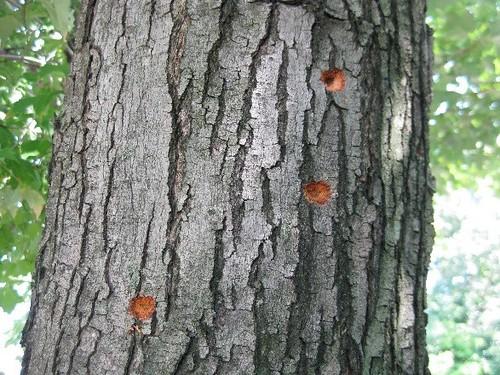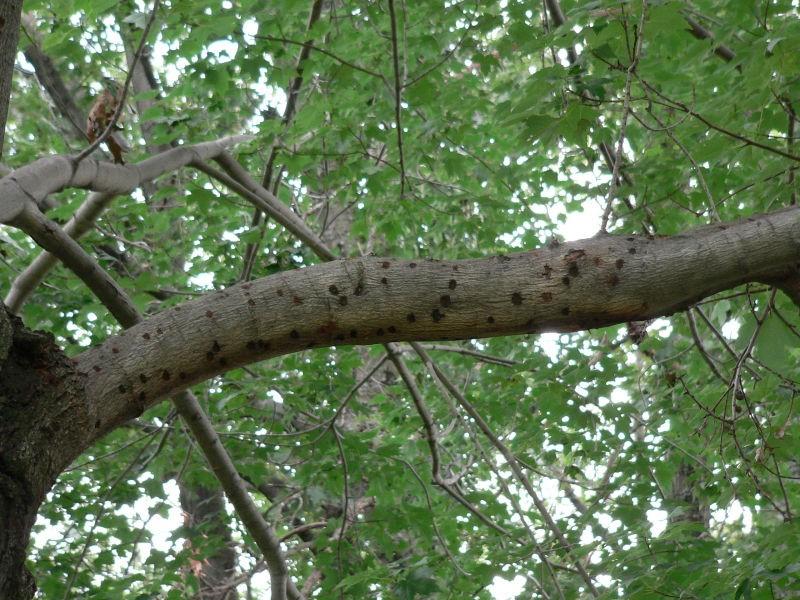The Asian Longhorned beetle (ALB), native to eastern China and Korea, is a wood-boring pest which feeds on a number of hardwood trees, eventually killing them, impacting both urban trees and forested sites. Wildlife habitat will be impacted due to loss of forest shelter and food sources. Industries such as such as lumber, maple syrup, nursery, commercial fruit, and tourism will feel an economic impact.
The first U.S. discovery of ALB was in Brooklyn, NY in 1996 and is believed to have arrived in wood packing material from Asia. The beetle has also been found in Illinois (1998), New Jersey (2002), Massachusetts (2008), Ohio (2011), and most recently, South Carolina (2020). It has not yet been found in Maryland, so let’s get familiar with this insect so we can spot if it does arrive. Because it has no known native predators, if the Asian Longhorned beetle becomes established in the U.S., it has the potential to cause more damage than the Dutch elm disease, chestnut blight, and gypsy moths combined. To see a map a map showing locations of the Asian Longhorned beetle, visit 2020 National ALB Program Overview.

The adult Asian Longhorned beetle is 1 to 1 ½ inches long, shiny black with white spots, and long antennae with black and white bands 1 ½ to 2 ½ times as long as the body, bluish feet (see Figure 1). It’s important not to mistaken this beetle with other insects. There are a number of similar species that one could confuse it with such as Whitespotted sawyer (Monochamus scutellatus). For images and a list of similar species, click on Asian Longhorned Beetle and its SE US Lookalikes.
There is one generation of ALB per year. The adults are present from July to October and later if temperatures are warm. Because ALB can overwinter in multiple life stages, adults emerge at different times. This results in their feeding, mating, and laying eggs throughout the summer and fall. While adult beetle activity is most obvious during the summer and early fall, adults have been seen from April to December. They usually stay on the trees from which they emerged or they will migrate short distances to find a new host to feed and reproduce. While the beetle can fly up to 8.5 miles from the host tree, the average flight distance is 1.4 miles.
Female ALM lay 35-90 eggs. She chews oval to round pits in the bark in which she lays eggs. The egg site in the bark may ooze sap, especially on maples. Eggs hatch into larvae within 10-15 days.
The larvae tunnel under the bark and feed on living tissue (phloem and cambium) and eventually into the woody tree tissue (xylem) through the fall and winter. They eventually pupate in the wood and emerge through round exit holes the following spring. The exit holes, found in live trees, are perfectly round, 1/4 inch or larger on trunk and branches larger than 1 ½ inches in diameter.

This feeding and burrowing in tree tissue will weaken the tree, causing the tree top to eventually die back and leaves will yellow out of season. Once the pest has sufficiently disrupted those pathways, the infected tree will die.
Another sign to look out for is frass, sawdust-like material or excrement, which may accumulation in branch crotches and around the base of infested trees. In the U.S., the Asian Longhorned beetle is known to attack 29 species of deciduous hardwood trees, preferring maples ,yet will indulge in alders, birches, elms, horse chestnut, poplars, sycamore, and willows.
So, how do you treat it?

Detection and eradication are needed to prevent or minimize the spread of this destructive insect. You are on your way, by learning how to ID an ALB infestation, noting what the egg masses look like, being able to ID those big exit holes, knowing the look alikes, and noting the frass. Also keeping an eye out for the symptoms such as leaf dieback and poor health.
USDA’s Animal and Plant Health Inspection Service is responsible for minimizing ALB’s entry to the U.S. It periodically conducts blitzes at ports-of-entry, extensively inspecting targeted Chinese shipments of solid wood packing materials to check for a variety of invasive species, including ALB.
For urban and residential areas, once detected, cutting, chipping and burning infected trees is the only proven method of control. The most common way the Asian Longhorned beetle spreads is through moving firewood from infected areas, so it is best to not move firewood out of regulated areas. Buy local, use local. If you have unused firewood, burn all of it or leave the wood on site. Of course, this requirement applies to any area with insect pest quarantines.
If you suspect you have found an Asian Longhorned beetle or found evidence of one, even if you are not sure, contact the Maryland Department of Agriculture. Be sure to save the beetle, even if it is already dead. Place the beetle in a secure container. Immediately call MDA at 410-841-5922.
So walk your woods frequently and get you know your trees, take some time to look closely for evidence of the Asian Longhorned beetle and any other forest pests. Remember, early detection is critical and the public must stay vigilant. Keeping your forests healthy benefits Maryland’s ecosystems and all Marylanders.
Recently, the insecticide Imidacloprid has presented good results when injected into individual trees and is increasingly being used in conjunction with other methods to protect trees and eradicate the pest. While two parasitoid wasp species have been identified that parasitize Asian Longhorned beetle larvae, they require more study before approved for release in the U.S. Also being researched is the use of fungal entomopathogens (a fungus that can behave as a parasite of insect, destroying or seriously disabling the insect). However, it has yet to be determined if the desired fungal species is native to North America. Breeding beetle resistant trees is yet another promising strategy.